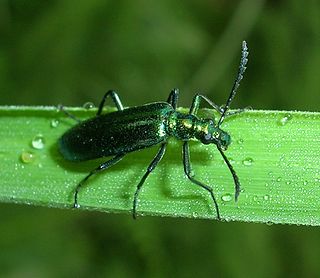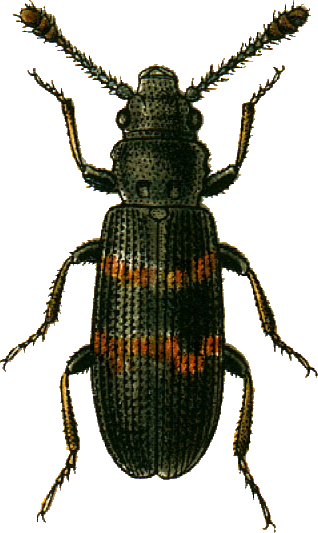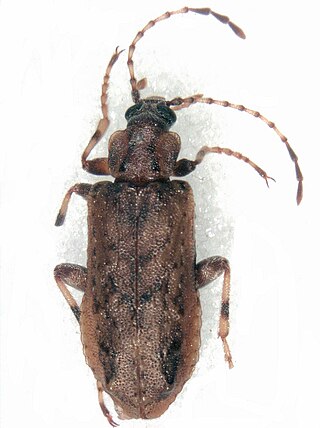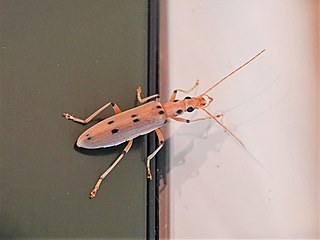
The sap beetles, also known as Nitidulidae, are a family of beetles.

The longhorn beetles (Cerambycidae), also known as long-horned or longicorns, are a large family of beetles, with over 35,000 species described.

Pyrochroa coccinea, commonly known as the black-headed cardinal beetle, is a species of cardinal beetle in the family Pyrochoidae. It is found mainly in wooded areas and pastures throughout central Europe, including southern Great Britain. Similar to other species of Ambrosia beetles, P. coccinea live and reproduce on wooden logs in early stages of decomposition. Larvae develop over the span of many years, with overlapping generations often inhabiting a single wooden territory. Adults, however, are short-lived and exist during a brief season. They typically show up in April, become more populous in May and early June, and become very rare in the remaining months.

The family Oedemeridae is a cosmopolitan group of beetles commonly known as false blister beetles, though some recent authors have coined the name pollen-feeding beetles. There are some 100 genera and 1,500 species in the family, mostly associated with rotting wood as larvae, though adults are quite common on flowers. The family was erected by Pierre André Latreille in 1810.

Mecodema oconnori is a large-bodied species of ground beetle that is found mainly on the western regions of the North Island, New Zealand. It is mainly found in native forest habitats, both intact and fragmented, and on the edges of pine plantations. Mecodema oconnori ranges from Otaki, Kapiti Coast to Raglan, but is also found in the Manawatu Gorge and some other eastern localities.

Oedemera nobilis, also known as the false oil beetle, thick-legged flower beetle or swollen-thighed beetle, is a beetle in the family Oedemeridae, a common species in Western Europe, including the south of England.

The minute tree-fungus beetles, family Ciidae, are a sizeable group of beetles which inhabit Polyporales bracket fungi or coarse woody debris. Most numerous in warmer regions, they are nonetheless widespread and a considerable number of species occur as far polewards as Scandinavia for example.

Oedemerinae are a subfamily of the false blister beetles, also known as pollen-feeding beetles. The Nacerdinae are sometimes merged here.

Calymmaderus is a genus of beetles in the family Ptinidae. There are about 11 described species in Calymmaderus.

Prionoceridae is a small family of beetles, in the suborder Polyphaga. They form a group within the cleroid beetles and were formerly treated as a subfamily (Prionocerinae) within the family Melyridae. Very little is known of their life history but most species are pollen feeders as adults and occur in large numbers during spring or the host flowering season. Larvae are predatory or feed on decomposing wood.

Phloeostichidae is a family of beetles in the superfamily Cucujoidea. They are typically found under the bark of dead trees. Larvae have been found to consume plant tissue and some fungi, while the adults appear to be exclusively fungivores. The family contains four extant genera, Phloeostichus is native to the Palearctic, Rhopalobrachium is native to central-southern South America and eastern Australia, Hymaea is native to southeastern Australia, and Bunyastichus is found in Tasmania.
Oxacis angustata is a species of false blister beetle in the family Oedemeridae. It is found in Central America and North America.
Xanthochroa lateralis is a species of false blister beetle in the family Oedemeridae. It is found in North America.

Asclerini is a tribe of false blister beetles in the family Oedemeridae. There are more than 40 genera and over 200 described species in Asclerini.

Pandeleteius is a genus of broad-nosed weevils in the family Curculionidae. There are over 150 described species in Pandeleteius, distributed across the Americas. Most species in the genus were described by Anne Howden.
Ditylus caeruleus is a species of false blister beetle in the family Oedemeridae. It is found in North America.
Eumecomera bicolor is a species of false blister beetle in the family Oedemeridae. It is found in North America.

Promecheilidae is a family of beetles in the superfamily Tenebrionoidea. Perimylopidae is considered a synonym. They are found in southern South America and associated archipelagos like South Georgia and the Falklands, New Zealand and Tasmania. Some species are associated tree ferns and moss-covered dead wood, and other forested habitats, while others are associated with peat bogs, grasslands and coastal habitats. They are probably phytophagus, feeding on lichen, moss, and other plant material.

Ischnomera is a genus of false blister beetles in the subfamily Oedemerinae.

Parisopalpus is a genus of false blister beetles in the family Oedemeridae. The genus was first identified by Logan Hudson in 1975, who separated the group from Sessinia due to the presence of bifid mandibles, and n males of the species visible genitalia.















